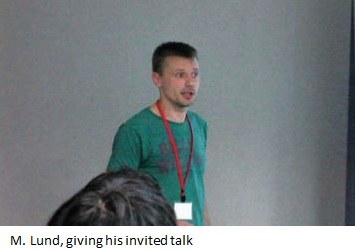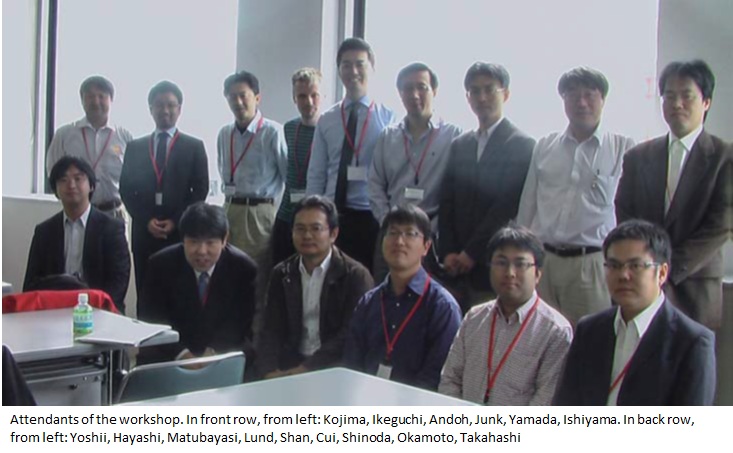Nagoya Satellite Workshop
CMSI Nagoya Satellite Workshop 2013
Large-Scale Molecular Simulations for Understanding Molecular Mechanisms
Researchers from Japan and other countries introduce the latest development trends
The satellite workshop of the CMSI International Symposium held in Nagoya October 17 - 19, 2013 featured presentations on the latest research achievements by up-and-coming young researchers involved in state-of-the-art research in Japan andother countries, on such topics as molecular dynamics (MD) and QM/MM researches using massively parallel computers and the study of protein, lipid membrane and other biomolecules. Researchers at home and abroad who are developing the software needed to execute calculations for these large-scale systems also explained the latest trends in software development. The venue for the workshop was the Nagoya Urban Institute, located on the 14th floor of a high-rise building adjacent to Kanayama Station. It was an impressive setting that afforded a panoramic view of Ise Bay. As the venue can be accessed directly from Chubu International Airport (Centrair) on the Meitetsu train line without the need to change trains, and it is also not far from JR Nagoya Station, it was undoubtedly convenient for not only the invited overseas guests as well as the researchers who came from other parts of Japan to attend.
The venue for the workshop was the Nagoya Urban Institute, located on the 14th floor of a high-rise building adjacent to Kanayama Station. It was an impressive setting that afforded a panoramic view of Ise Bay. As the venue can be accessed directly from Chubu International Airport (Centrair) on the Meitetsu train line without the need to change trains, and it is also not far from JR Nagoya Station, it was undoubtedly convenient for not only the invited overseas guests as well as the researchers who came from other parts of Japan to attend.
This satellite workshop featured three invited guests from overseas countries. Qiang Cui (University of Wisconsin, U. S. A.) is conducting intensive research into the chemical reactions of biomolecules using QM/MM calculations. Mikael Lund (Lund University,Sweden) is conducting large-scale simulations of protein molecule mixing using a unique coarse graining model that considers pH. Tzu Ray Shan (Sandia National Laboratories,U. S . A.) was one of the members of the team that developed Large-scale Atomic/Molecular Massively Parallel Simulator(LAMMPS), the well-known general molecular dynamics calculation software for parallel computing use. (Weitao Yang, who is well-known for his work on the density functional theory, participated in the international symposium at The University of Tokyo only.) The speakers from Japan were Mitsunori Ikeguchi (Yokohama City University),who has pursued extremely intensive research into proteins and other biologically relevant molecules; Nobuyuki Matsubayashi(Kyoto University); Hideaki Takahashi (Tohoku University); Takefumi Yamashita (The University of Tokyo); Wataru Shinoda (Nagoya Universiry), who is working to develop coarse graining models; Tatsuya Ishiyama(Tohoku University), who conducts wide-ranging research on interfacial systems; and Kazushi Fujimoto (Ritsumeikan University).All of the participants are engaged in cutting-edge research that makes use of the breadth of latitude afforded by massively parallel machines and broadens the horizons of research, and the discussions at the workshop were lively.
Current state of increased speed and use of massively parallel computing for MD calculations
One of the main topics of the workshop was increased speed and the use of massively parallel computing for molecular dynamics calculations. Jaewoon Jung spoke about the GENESIS program being developed at RIKEN, Tzu Ray Shan spoke about LAMMPS, which was developed by Sandia National Laboratories in the United States,and Yoshimichi Andoh spoke about MODYLAS,which was developed mainly by the Okazaki Laboratory at Nagoya University.The workshop was an excellent opportunity to learn about the current state of performance and other aspects of state-of-the-art MD calculation software that is designed for massively parallel computing. In addition,Kenji Yasuoka gave a very interesting talk on efforts to increase the speed of MD calculations using special purpose computers,which also touched on the history of development.
On both of the evenings during the period of the workshop, the participants took the opportunity to enjoy themselves and deepen friendship while sampling Nagoya regional specialties that included the famous tebasaki (chicken wings) in the area around Kanayama Station.
(Noriyuki Yoshii, Nagoya University)


